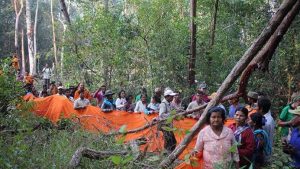
“To see the Buddha” means “to achieve samadhi”
In the Contemplation Sutra, Queen Vaidehi requests that the Buddha teach her how to be reborn in the Land of Bliss through meditative practice (cultivation of the mind). That is, she wishes to learn to contemplate, to perceive the Land of Bliss, and then to achieve samadhi (the highest state of meditation), hoping to attain rebirth in the Land of Bliss.
If one wishes to be reborn in the Brahma Heavens, the Extremely Bright Pure Heavens, or the Universally Pure Heavens, one must first attain the divine eye (there are five classes of eye: human eye, divine eye, Dharma eye, wisdom eye, and Buddha eye; with the divine eye one can perceive the heavens), and then achieve the first, second, and third states of profound meditation (dhyana), respectively. In visualizing the scenes of a particular dhyana heaven through one’s own effort in meditative practice, one has attained the meditative virtues “qualifying” or “entitling” one to be reborn there—although entering the fourth dhyana heaven is more complicated.
All four levels of dhyana heaven, together with the various sub-levels (18 in total), form the Domain of Matter (Rupadhatu) in the Saha World. There are four higher heavens in the Domain of Non-matter (Arupadhatu), which can be reached through the fourth and highest state of dhyana meditation. However, all beings in these heavens remain subject to reincarnation within the Three Domains and the Six Realms of the Saha World.
Knowing that the Land of Bliss is more splendid than all the dhyana heavens in the Saha World, Queen Vaidehi rightly thinks that she may need to attain an even higher level of meditative virtue—samadhi—to visualize it and hopefully qualify for rebirth there. She therefore sensibly requests that the Buddha teach her to visualize the Land of Bliss and Amitabha Buddha through meditative practice to achieve samadhi.
Samadhi is a special term with regard to meditative practice; however, in Pure Land Buddhism it has a particular yet simple meaning. As stated in the Contemplation Sutra: “Those who have envisioned them see all the Buddhas of the 10 quarters. Because of seeing the Buddha, it is called the samadhi of Amitabha-invocation,” whether we see him during meditation or recitation, in a dream, or under any circumstance, such as near the end of our life.
Achieving the samadhi of Amitabha-contemplation
The Contemplation Sutra says, “Then the World-honored One said to Vaidehi, ‘Do you know that Amitayus [Amitabha] is not far away? Fix your thoughts upon and contemplate that Buddha land, then you will accomplish the pure acts.’”
Master Shandao explains the sentence “fix your thoughts upon and contemplate that Buddha land” as follows: It indicates that the heavy karmic obstructions of ordinary beings are deep, and their fragmented minds are scattered and unfocused. If they cannot promptly renounce all karmic connections, there is no reason for the pure scenes of the Buddha land to be visualized. It then becomes impossible to accomplish the pure acts of the meditative virtues.
Although Shakyamuni Buddha discourages Queen Vaidehi from visualizing the Land of Bliss for rebirth there through meditative practice, saying that she lacks the divine eye, he promises to teach Vaidehi the procedure, step by step, to cultivate her mind and attain meditative virtues through her own power and to achieve the samadhi of Buddha-contemplation, as follows:
The divine eye is a prerequisite for all practitioners seeking to achieve the samadhi of Buddha-contemplation. It is also an expedient means to visualize the sun and water in our mundane and unreal world, as stipulated in the First and Second Contemplations in the Contemplation Sutra; this is known as the “unreal environment as circumstantial reward.”
The Third (the ground), Fourth (trees), Fifth (ponds), Sixth (pavilions), and the Seventh (the Lotus Throne) Contemplations refer to the contemplation of the “real environment as circumstantial reward,” the real environment of the Land of Bliss, the realm of unconditioned nirvana adorned with Amitabha’s real merits and virtues.
The Eighth Contemplation is the contemplation of Amitabha’s form, which is known as “unreal direct reward,” because it is also an expedient means by which to help practitioners in the Saha World contemplate Amitabha’s real body. The Ninth (the true body) Contemplation is the highlight of the Contemplation Sutra. If one eventually sees the true body of Amitabha Buddha through meditative practice, one will achieve the samadhi of Buddha-contemplation.
Two ways to see Amitabha Buddha and attain samadhi
In the Ninth Contemplation, Shakyamuni Buddha makes an important remark: “Each [ray of Amitabha’s] light shines universally upon the lands of the 10 quarters, embracing, and not forsaking, those who recite the name of the Buddha.” In other words, one can also visualize Amitabha Buddha by achieving the samadhi of Buddha-invocation through the Buddha power as a result of invoking him or reciting his name.
To conclude, there are two ways to see the Land of Bliss and Amitabha Buddha (in the state of samadhi). In his Commentary on the Contemplation Sutra, Master Shandao says, “Here, the objective of the Contemplation Sutra is the samadhi of Buddha-contemplation [Amitabha Buddha], and the samadhi of Buddha-invocation [Amitabha-recitation] as well. Its substance is rebirth in the Pure Land through single-minded dedication and aspiration.”
The former is based on the practitioner’s own power, depending on his own ability, while the latter is based on the power of Amitabha’s vow, independent of the practitioner’s ability. I will elaborate on the samadhi of Buddha-invocation in the next article. At this point, it is important to note that we talk about seeing Amitabha Buddha and achieving samadhi only. However, as far as the rebirth of the Pure Land aspirant is concerned, the key point is single-minded dedication and aspiration, as indicated by Master Shandao.
If one does not single-mindedly dedicate one’s own merits and virtues (including the meditative virtue of the samadhi of Buddha-contemplation through the aspirant’s own practice) and aspire to be reborn in the Land of Bliss, one will not be welcomed and received by Amitabha Buddha into his homeland. We will discuss this complicated concept in later articles.
See more
Shakyamuni Buddha’s Responses to the Three Requests of Queen Vaidehi (Buddhistdoor Global)
An Unusual Sutra Revealed (Buddhistdoor Gobal)











